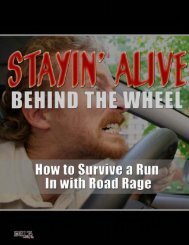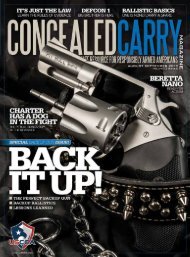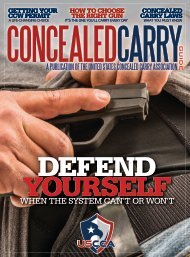Download This Issue - US Concealed Carry
Download This Issue - US Concealed Carry
Download This Issue - US Concealed Carry
You also want an ePaper? Increase the reach of your titles
YUMPU automatically turns print PDFs into web optimized ePapers that Google loves.
There are worse things<br />
than being shot, and<br />
killing your own child or<br />
spouse is one of them.<br />
name of article here<br />
<strong>This</strong> is a continuation of our discussion from a previous<br />
column (Behind the Line, CCM January 2011) concerning<br />
shooting techniques for low light encounters.<br />
To recap our earlier discussion,<br />
there is a distinct difference between<br />
the low light needs of a<br />
SWAT police officer or a military door<br />
kicker (who are both quite often tasked<br />
with going into dark places to actively<br />
seek out bad guys) and the role of<br />
the private citizen in self defense. The<br />
flashlight is a “proactive instrument,”<br />
whereas the handgun is a “reactive instrument.”<br />
In a typical street robbery,<br />
carjacking, or similar crime resulting in<br />
a need for immediate self defense, there<br />
will be neither the time nor the need to<br />
deploy a flashlight. These events do not<br />
take place in total darkness, and the<br />
range involved is typically quite short,<br />
particularly in a low light environment.<br />
Realistically, about the only circumstance<br />
involving a flashlight and a<br />
handgun at the same time for a private<br />
citizen is in the home, at night, when<br />
investigating the proverbial “things<br />
that go bump in the night.” Here again<br />
though, the mission is still quite different<br />
for the homeowner and the SWAT officer<br />
serving a warrant. The homeowner<br />
should know the layout of the home, the<br />
location of choke points and obstacles,<br />
and have a general plan of action built<br />
on that knowledge. He won’t need the<br />
flashlight for navigation. Actually, the<br />
primary purpose of the flashlight for the<br />
homeowner will be target identification<br />
and target discrimination. The armed<br />
homeowner needs to know for certain if<br />
that is an intruder in the hallway or his<br />
teenage son sneaking in after curfew.<br />
Unless you live alone, this is a circumstance<br />
fraught with the possibility of a<br />
tragedy of disastrous proportions! You<br />
must know who that is before pointing<br />
a loaded deadly weapon at them under<br />
highly stressful conditions. There are<br />
worse things than being shot, and killing<br />
your own child or spouse is one of them.<br />
Let’s start with weapon-mounted<br />
lights, which are very fashionable right<br />
now. Almost all current defensive handgun<br />
designs include rails on the dust cover<br />
to allow the attachment of a compact<br />
light source, and several manufacturers<br />
make rugged, dependable pistol lights<br />
with high light output. Some years ago, I<br />
felt that these were a sensible addition to<br />
a dedicated home defense handgun, or<br />
“nightstand pistol,” particularly if coupled<br />
with a high capacity autoloader. If<br />
the homeowner grabbed the gun in the<br />
middle of the night, he would likely have<br />
enough ammo in a high-cap pistol, and<br />
the light source already attached would<br />
not have to be found and grabbed separately.<br />
However, recent developments<br />
have changed my opinion.<br />
In the past few months there have<br />
been two negligent shootings (one fatal)<br />
of unarmed suspects by police officers<br />
with a weapon mounted light on a<br />
handgun who were trying to illuminate a<br />
suspect. In both cases, the officer meant<br />
to activate the light, and unintentionally<br />
fired the gun, striking the suspect.<br />
Go back to the second paragraph above.<br />
If you are trying to light up the shadowy<br />
figure in the hall, but shoot your<br />
child unintentionally, you will have to<br />
live with the consequences. There are<br />
several factors at work here that make<br />
these tragedies more likely. First, few<br />
homeowners are going to train with the<br />
light on the gun to the point of learning<br />
to work the switches without getting a<br />
finger near the trigger, particularly under<br />
high stress. I’m not talking about<br />
getting practice firing the gun with the<br />
light attached. I’m talking about practicing<br />
using the light without firing the<br />
gun. Second, the Force Science Institute<br />
and other highly respected sources<br />
have documented the phenomenon of<br />
“trigger searching,” even among highly<br />
trained and skilled SWAT operators. Do<br />
a quick Google search on Force Science<br />
and “trigger search” for further enlightenment<br />
(forgive the pun). Third, if the<br />
only light you have is a weapon mounted<br />
light, you have to point the gun at<br />
everything you look at; a clear violation<br />
of Rule Two (never point your gun at<br />
anything you are not willing to destroy).<br />
Remember, the purpose of an illumination<br />
tool is to identify and discriminate<br />
a target before pointing a gun at it.<br />
<strong>This</strong> is not possible if your only light is<br />
weapon mounted. So, the bottom line<br />
is, even if you have a weapon mounted<br />
light (WML), you have to have a hand<br />
held light, as well. The WML is strictly for<br />
shooting, not for searching or for target<br />
identification.<br />
That brings us to hand-held flashlight<br />
techniques. We’ll discuss these in detail<br />
in the third installment in this series. H<br />
Tom Givens is the owner of Rangemaster<br />
in Memphis, TN. For over 30 years Tom’s<br />
duties have included firearms instruction.<br />
He is certified as an expert witness<br />
on firearms and firearms training, giving<br />
testimony in both state and federal<br />
courts. He serves as an adjunct instructor<br />
at the Memphis Police Department<br />
Training Academy, the largest in the<br />
state. Tom’s training resume includes<br />
certification from the FBI Police Firearms<br />
Instructor School, NRA Law Enforcement<br />
Instructor Development School, NRA<br />
Law Enforcement Tactical Shooting<br />
Instructor School, Gunsite 499 under Jeff<br />
Cooper, and more.
















